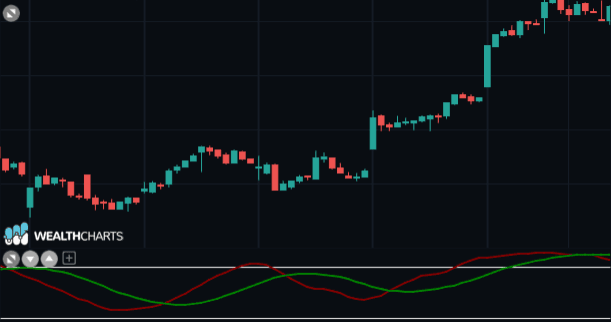Categories
About UsHow to get startedAccount AccessBrokers and TradingScannersResearch ToolsCommunityStocksOptionsFuturesAlertsStochastic - Indicator Formula
The fundamental concept of the indicator in the analysis is based on the conviction that the closing price, considered the most meaningful, is close to the maximum levels of the session in situations of increase, while in the bearish phase the closing is close to the minimums of the session.
Consequently, in uptrend situations, the observation of excursions characterized by new highs and closures placed around the minimums, indicate a weakening of the bullish phase. In the case of a downtrend, the opposite considerations apply.
Lane's first index, %K, has the following analytical form:
%K( t ) = 100 * C( t ) - L( NP0 ) / H( NP0 ) - L( NP0 )
%KS( ) = SMA of %K( ) for NP1 periods
%KD( ) = SMA of %KS( ) for NP2 periods
where:
C( t ) = current closing price
H( NP0 ) = maximum price recorded over time NP0
L ( NP0 ) = minimum price recorded over time NP0
NP0 = number of periods of %K
NP1 = number of periods of the %KS
NP2 = number of periods of the %KD
During the current session t it is essential to identify the values:
H( NP0 ) = the maximum between H( t ), H( t - 1 ), ... H( t - NP0 + 1 )
L( NP0 ) = the minimum between L( t ), L( t - 1 ), ... L( t - NP0 + 1 )
The values are updated in the following time units. It can be well understood that the development of the %K index requires a set of data with maximum, minimum and closing prices.
A critical choice concerns the size n; the amplitude of the time interval n can only result from a careful verification of the historical performances determined by the application of the operating signals received from the %K curve.
As the %K indicator has an oscillation range of 100, it is possible to identify zones within which the curve moves expressing particular market conditions:
the range between the values (80, 100); this is a phase in which the upward trend is probably, at a point of exhaustion, not being able to continue to withstand the high levels of prices. In this case (overbought phase) there is a strong imbalance between supply and demand with a predominance of buyers.
the range between the values (0, 20); this is a phase of the bearish trend in which the continuous sales (oversold phase) lead to the complete dominance of the supply over the demand; it is plausible to expect a return of the bull force of the market, also for the particularly attractive prices for a purchase.
the range between the values (20, 80); this is a neutral range of oscillation. A substantial balance between supply and demand is assumed at this stage.
From the identification of the above steps, indications can be obtained for buying and selling transactions: buying when the %K is in the oversold zones and selling when the %K moves in the overbought range.
To remedy the marked variability of the oscillations of the %K curve, a process of equalization by simple moving average is introduced; a new indicator, called K Slow (%KS), is thus obtained.
In this type of indicator, the overbought zone will be identified in the 70-100 range, while the oversold zone is reported in the 0-30 range.
The last indicator provided in this model is an additional simple smoothing for the moving average of the KS curve, it is called D Line (%DL).
At this point it must be said that the most significant operational signals proposed by G. Lane concern two aspects: on the one hand the interaction between two indicators of the model (usually %KS and %DL) is observed and on the other hand, there are possible differences between the trend of the price and that of the most averaged indicator (%DL).
